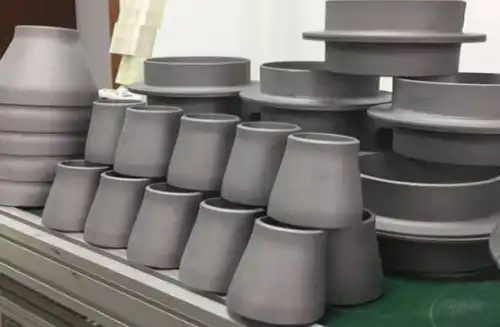Titanium materials, as an important metal material, are widely used in many fields such as aviation, aerospace, and ocean. Due to its unique physical and chemical properties, titanium materials often need to undergo a series of surface treatments during the manufacturing process to improve their performance and service life. Among them, sandblasting is a commonly used surface treatment method.
Sandblasting mainly uses compressed air as a power source to spray materials (such as copper ore sand, quartz sand, corundum, iron sand, sea sand, etc.) in the form of a high-speed jet beam onto the surface of the workpiece to be treated. This high-speed jet can hit the surface of the workpiece, causing the appearance or shape of the workpiece surface to change, thereby achieving a variety of effects such as cleaning, deburring, and increasing roughness.

The purpose of sandblasting of titanium materials mainly includes the following aspects:
Burr cleaning and surface beautification of machined parts: During the production process, some defects such as the oxide layer, sintering layer, pores, burrs, etc. often remain on the surface of titanium machined parts. Through sandblasting, these defects can be effectively removed, making the surface of the workpiece smoother and neater.
Improve the mechanical properties of parts: Sandblasting can improve the surface roughness of titanium materials and increase surface activity, which is beneficial to subsequent surface treatment processes such as electroplating and spraying. At the same time, sandblasting can also improve titanium materials' fatigue and wear resistance to a certain extent.
Polishing effect: For titanium alloy products, the appearance of the appearance is also very important. Through sandblasting, the product's appearance can be beautified, making the surface brighter and smoother, and improving the overall quality of the product.
Stress elimination and surface strengthening: In the manufacturing process of titanium materials, some internal stresses are often generated. Through sandblasting, the impact of sand shots can be used to eliminate these stresses and increase the strength of the workpiece surface.
When sandblasting titanium materials, there are several important influencing factors to pay attention to:
Grit material and mesh: Different grit materials and meshes have a direct impact on the sandblasting effect. Generally speaking, white corundum is used as the sandblasting material for titanium material sandblasting, and the mesh is selected according to specific needs. Common ones are 24 mesh, 36 mesh, 46 mesh, 54 mesh, 64 mesh, etc.
Gas pressure: The size of the gas pressure determines the injection speed and strength of the sandblasting beam. When sandblasting titanium materials, the gas pressure is generally controlled between 0.3-0.6MPa.
Sand flow and sandblasting time: Sand flow and sandblasting time are also important factors affecting the sandblasting effect. Excessive sand flow or long sandblasting time may cause excessive wear or deformation of the workpiece surface. Therefore, in actual operation, it is necessary to reasonably adjust the sand flow and sandblasting time according to the size, area, and final effect of the product.
In addition, when sandblasting titanium materials, the following safety precautions should be noted:
Protective equipment such as protective glasses, masks, gloves, etc. must be worn before work to prevent dust and splashes generated during sandblasting from causing harm to personnel.
Equipment such as gas tanks, pressure gauges, and safety valves should be calibrated regularly to ensure their safety and reliability.
Ventilation and dust removal equipment should be turned on before work to ensure that the air circulation and dust concentration in the workplace are controlled within a safe range. It is prohibited to turn on ventilation and dust removal equipment when the sandblasting machine is working to prevent dust from flying.
After the work is completed, the ventilation and dust removal equipment should continue to operate for five minutes before shutting down to exhaust the residual dust in the room and keep the site clean.
In short, sandblasting of titanium materials is a common surface treatment method. Reasonable sandblasting can improve the surface finish and corrosion resistance of titanium materials. In actual operation, it is necessary to select appropriate sandblasting materials, mesh size, gas pressure, flow rate, sandblasting time, and other parameters according to the specific situation, and strictly abide by the safety operating procedures to ensure the quality of sandblasting and the safety of personnel.











